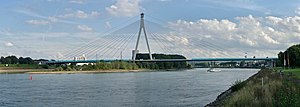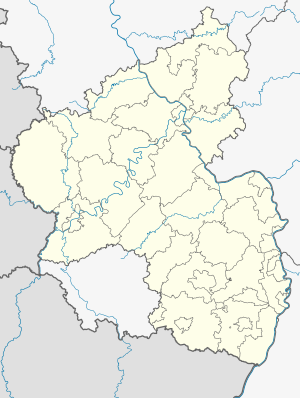Raiffeisen Bridge
Coordinates: 50 ° 25 ′ 17 ″ N , 7 ° 27 ′ 29 ″ E
|
|
||
|---|---|---|
| Official name | Rheinbrücke Neuwied - Raiffeisenbrücke | |
| use | Federal road | |
| Convicted | Federal Highway 256 | |
| Crossing of | Rhine | |
| place | Weißenthurm - Neuwied | |
| construction | Cable-stayed bridge | |
| overall length | 485 m | |
| width | 35 m | |
| Longest span | 238 m | |
| building-costs | 130 million DM | |
| start of building | 1974 | |
| completion | 1978 | |
| opening | September 28, 1978 | |
| location | ||
|
|
||
The Raiffeisenbrücke is a bridge over the Rhine between the cities of Neuwied and Weißenthurm . It is part of the federal highway 256 . Because of the new construction and relocation process at the time, it was considered a top technical achievement.
The bridge has six lanes, with the right-hand lane serving as an acceleration and turning lane on both sides. In addition, there is a shared walking and cycling path on both sides . Up to 35,000 vehicles cross the bridge every day.
The Rhine bridge is named after the Heddesdorf mayor, founder of the cooperative and social reformer Friedrich Wilhelm Raiffeisen .
Predecessor bridges
Caesar's Rhine Bridge
→ Main article: Caesar's Rhine bridges
The Roman general Gaius Iulius Caesar had in 55 BC BC build a solid wooden bridge over the Rhine near today's Raiffeisenbrücke in order to be able to carry out a punitive expedition against the Teutons on the right bank of the Rhine. Caesar described the course of the war in his classic work De bello Gallico and thus also left a description of this technical achievement. In 1885, oak piles were excavated from the river in the Rhine near Neuwied with an excavator. Their age dates back to the middle of the 1st century BC. Could be determined. Two years later (53 BC) Caesar repeated the crossing of the Rhine. This bridge was probably located near today's Urmitzer railway bridge .
Pioneer bridges
Short-lived pioneer bridges helped Marshal Henri de La Tour d'Auvergne, vicomte de Turenne in 1673 and an Anglo-Dutch army in 1743 and then between 1795 and 1797 the French revolutionary troops here across the Rhine. In 1817 a "flying bridge" was built as a Gierponte .
First road bridge over the Rhine
In the 1880s there were first considerations to build a permanent bridge over the Rhine. In 1887 Anton Gutacker, who also built the Irlich railway bridge over the Wied, made a first draft. In 1925, an association was founded to promote bridge building in order to advance the planning. A competition announced in 1933 received 33 designs; the foundation stone was laid on March 21, 1934 and the bridge was opened on November 3, 1935. The bridge was named Hermann Göring Bridge after her godfather. The 686 m long bridge train had an 8.5 m wide carriageway for one lane in each direction as well as 2.0 m wide sidewalks on both sides. Bridge fees had to be paid at the bridge houses at both ends. During World War II , the bridge was bombed on January 16, 1945 by B-26 Marauders of the 9th Air Force. It then collapsed and blocked the Rhine waterway.
construction
The river bridge was a postless, steel strut framework construction with an underlying carriageway and the continuous beam as a structural system in the longitudinal direction. With a total length of 456.91 m, it had three openings with spans of 178.75 m, 66.00 m and 212.16 m. The 0.5 m wide lattice main girders had a system height of 16.0 m with a center distance of 13.5 m. The steel structure weighed 3700 tons. The bridge was supported on four massive piers which were 20.5 m wide, 4.5 m thick and 13.5 m high in the river area. The foundation was on natural gravel with underwater concrete in open construction pits. The truss bridge was partly built on wooden auxiliary pillars and partly cantilevered .
Emergency bridges and rebuilding
The Americans built an emergency bridge in June 1945, which was completely destroyed in a huge ice drift in February 1947. In 1949, the French occupiers used the salvaged steel parts of the bridge that collapsed in 1945 to build a bridge that was completed in 1951. In the 1960s, the new building was put on the federal emergency list. In August 1977 the old bridge was dismantled.
Construction of the Raiffeisen Bridge
The construction of the new Rhine bridge was preceded by several years of planning, which also included the question of the location. One of the considerations was that a new bridge ( Südbrücke ) should be built in the south of Neuwied and that the old one should remain as a city bridge . The construction time was planned to be four years; such a long interruption of the road connection over the Rhine would have led to considerable traffic problems, because the next bridges up the Rhine were in Bendorf, around 10 km away, and down the Rhine in Bonn , around 50 km away , both on the right bank of the Rhine only via federal highway 42 could be reached. At that time, this federal road still went through the sometimes narrow places along the Rhine and consisted mainly of cobblestones. So it was decided to build the new bridge right next to the old bridge that was still in use during the construction period and to move it later.
The groundbreaking next to the Neuwied bridgehead took place on June 27, 1974. The Rhineland-Palatinate Economics Minister Heinrich Holkenbrink , State Secretary Kurt Jung from the Federal Ministry of Transport and the heads of the towns of Neuwied and Weißenthurm took part in the celebrations.
Piers and approach bridges
The pylon pillars on the island of Weißenthurmer Werth were erected with a center distance of only 38 m between the island piers of the old bridge. The upstream extension, which was only used for the construction period, was demolished after the bridge was completed. The final part under the old bridge has already been clad with ashlars. For the island piers and the bridgehead bearings on both banks, 21,000 m³ of concrete and 1,500 t of reinforcing steel were required, for the structures of the approach bridges a further 32,000 m³ of concrete, 2,300 t of reinforcing steel and 1,000 t of prestressing steel.
On the Weißenthurm side, a 525 m long foreland bridge was built as an elevated road on pillars up to 15 m high to cross the railway line on the left bank of the Rhine and the old route of federal highway 9. On the Neuwied side, the structures of the access roads are 1.5 km.
Pylon and bridge body
A mobile crane, which was transported to the island by river pioneers and which could be extended up to a height of 130 m, was used to assemble the pylon. On the first bridge platform above the two pillars, the two inclined pylon posts were raised by placing prefabricated parts on top of each other. The stems were connected with three head parts, the pylon reaches a height of 88 m above the roadway and 105 m above the island. Inside the pylon, stairs with 216 steps lead to the top of the pylon; a lift was later installed. The ropes near the pylon are 95 m long and have a diameter of 102 mm, the outermost ones are 235 m long and 119 mm thick. Each of the 44 steel ropes (spiral wire ropes) can carry the load of 35 fully loaded freight wagons, the total load hanging on the ropes is 12,000 t.
The bridge structure, designated as the superstructure, was assembled from individual parts (joints) that were prefabricated in Lauterburg in Alsace and delivered by ship. The joints weighed up to 90 t and, after they had been lifted to the bridge ends with cranes, were welded to the growing bridge and attached to the ropes connected to the pylon.
Moving the new bridge
The bridge ramp of the old bridge was blown up in February 1977, and from July the valley-side double lane of the new bridge was opened to traffic. The old bridge was prepared for demolition. In August, 110 m on the Neuwied side and 170 m on the Weißenthurmer side were cut out, lowered onto special ships from the Netherlands and deposited on the Weißenthurmer Werth , where they were later dismantled.
On February 18, 1978 the new bridge was moved from its construction site to the place of the old bridge. It was the second Rhine bridge relocation after the Oberkasseler Bridge in Düsseldorf had been relocated the year before . The Raiffeisen Bridge was raised by 3 cm and lowered onto 1.80 m wide polytetrafluoroethylene- coated sliding plates made of stainless steel at the two bank abutments and on the two island piers . The bridge was pulled into its new position on 120 steel wire ropes at a speed of 1 mm per second using hydraulic oil presses with a thrust of 200 t. In 14 hours the bridge was moved 16.25 m down the Rhine and into its final position, exactly in the axis of its predecessor. The sliding plates were removed after lifting again. Finally, various remaining work was required, including a. 60,000 m² of paint had to be applied.
On September 28, 1978, after a four-year construction period, the bridge was officially opened to traffic. The cost of the Rhine bridge was around 60 million DM, and for the approach bridges around 70 million DM.
Technical specifications
- Cable-stayed bridge in steel construction
- Height of the pylon: 91.77 m (88 m above the roadway)
- Number of ropes: 44 (22 on each side)
- Length of the main bridge: 485 m
- Spans: 235 m - 38 m - 212 m
- Clear height above the Rhine: 17.70 m
- Height of the steel superstructure: 2.42 to 2.80 m
See also
Web links
Individual evidence
- ↑ Helmut Schnatz: Koblenz in the bombing war in: historicum.net
- ^ Tils: Preliminary report on the construction of the road bridge over the Rhine between Neuwied and Weissenthurm. In: The civil engineer. 15th year, 1934, pp. 439–442.
|
The next bridge upstream: Caesar's Rhine bridges (historical, 55 BC) Urmitzer railway bridge |
Bridges over the Rhine |
The next bridge downstream: Ludendorff Bridge (destroyed in 1945) Konrad Adenauer Bridge (Bonn) |






